Methods Of Diagnosing And Treating Pulmonary Diseases Or Disorders
- Summary
- Abstract
- Description
- Claims
- Application Information
AI Technical Summary
Benefits of technology
Problems solved by technology
Method used
Image
Examples
example 1
A Predictive Statistical Model (ELEN Index) Using Peripheral Blood Cell Counts Successfully Categorizes Asthmatics into Sputum Eosinophilic and Non-Eosinophilic Phenotypes
Materials and Methods
[0252]To develop and validate a statistical model for predicting eosinophilic asthma, we used data from a clinical trial (CP-138) conducted by MedImmune for testing one of its proprietary compounds (MEDI-528), an anti-IL-9 antibody. We used a multivariate technique, Linear Discriminant Analysis (LDA), for developing a prediction algorithm (McLachlan, G. J., 1992; Huberty, C. J., 1994). The statistical software SYSTAT v. 11.0.0.1 was used for data analyses (SYSTAT, 2004).
[0253]Independent validation of the prediction model was carried out with a different dataset obtained from Astra Zeneca (AZ). The CP-138 clinical trial was conducted on 30 mild asthmatics all of whom underwent an allergen bronchial challenge and subsequently received the anti-IL-9 treatment. The 30 mild asthmatics were randomly...
example 2
Treatment of Eosinophilic-Positive or Eosinophilic-Negative Subjects Predicted by Using a Statistical Model (ELEN Index) and FENO Measurement
Methodology
[0272]A Phase 2b, randomized, double-blind, placebo-controlled, dose-ranging, multicenter study is conducted to evaluate the efficacy and safety of multiple-dose administration of an anti-IL-5R monoclonal antibody (benralizumab) in adult subjects with uncontrolled asthma requiring medium-dose or high-dose inhaled corticosteroid (ICS) plus long-acting β2 agonists (LABA) and having a history of ≧2 but ≦6 documented asthma exacerbations in the 12 months prior to screening that required use of a systemic corticosteroid burst. In this study, subjects are classified and stratified according to eosinophilic phenotype (eosinophilic-positive or eosinophilic-negative) as determined by the “ELEN Index” described in Example 1 above and by FENO measurement.
[0273]In particular, a subject is considered to be eosinophilic positive if the ELEN Index ...
example 3
A Predictive Statistical Model Combining a Peripheral Blood Cell Counts and FENO Measurements (EL-FENO Index)
[0283]A FENO cutoff at 50 ppb has high specificity for identifying eosinophilic asthmatics, but its sensitivity is very low. There have been attempts to adjust the appropriate cutoffs for FENO based upon patient's height, age, smoking status, and atopy (defined as the presence of specific IgE), which have resulted in publication of reference equations; but such reference equations only account for 9 to 11% of the variation (Olin et al., 2007). According to Olin et al. (2007), the most important information that could be extracted from the study is that the upper limits of FENO range from 24.0 to 54.0 parts per billion, depending upon age and height. Thus, applying a FENO cutoff of 50 ppb for all subjects (irrespective of their other biophysical attributes) in the absence of other classifiers is at best an inefficient diagnostics criterion that misses many eosinophilic patient...
PUM
| Property | Measurement | Unit |
|---|---|---|
| Ratio | aaaaa | aaaaa |
| Therapeutic | aaaaa | aaaaa |
| Whiteness | aaaaa | aaaaa |
Abstract
Description
Claims
Application Information
 Login to View More
Login to View More - R&D
- Intellectual Property
- Life Sciences
- Materials
- Tech Scout
- Unparalleled Data Quality
- Higher Quality Content
- 60% Fewer Hallucinations
Browse by: Latest US Patents, China's latest patents, Technical Efficacy Thesaurus, Application Domain, Technology Topic, Popular Technical Reports.
© 2025 PatSnap. All rights reserved.Legal|Privacy policy|Modern Slavery Act Transparency Statement|Sitemap|About US| Contact US: help@patsnap.com



